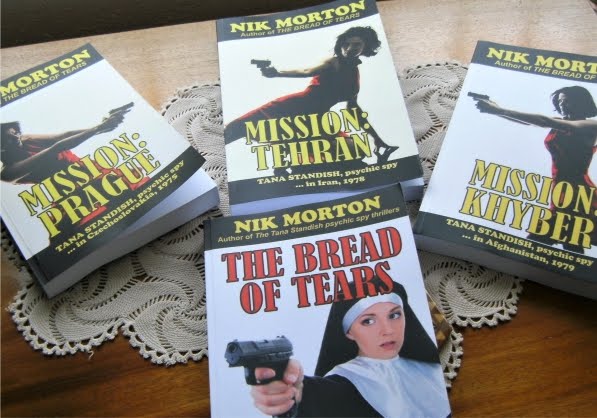I was drawn to the book Jet by Russell Blake because the cover
shares the same model as my book Mission:
Prague (see the two covers to compare below).
The similarities don’t end
there, either. Maya, codename Jet is a twenty-eight-year-old Mossad assassin.
The heroine in Mission: Prague is
psychic spy Tana, a survivor of the Warsaw ghetto; she was thirty-eight at the
time of her Prague mission.
Jet’s
adventures are set in the present, while Tana’s are in the past (Czechoslovakia,
1975; Iran, 1978; Afghanistan, 1979).
Tana’s Prague novel first
came out in 2008 as The Prague Manuscript.
Jet was published in 2012, though the
‘shared’ model did not appear on the new Prague cover until 2017.
Both books are fast-paced.
Jet – the first
book in the series
Maya thought she’d left behind
her life of violence and had retired to Trinidad. Unfortunately, somebody from
her past had talked and sent an assassination squad to eliminate her. From the explosive
beginning to the traumatising end, it’s action all the way. I certainly want to
read more in the series!
Russell Blake has produced a
page-turning thrill-ride that has built up an enviable fan base. And to his
fans’ delight he’s prolific. He’s just produced his SEVENTEENTH Jet novel (including
two prequels) plus a host of other series; in all, in seven years he’s written
about 60 books (and co-authored two with Clive Cussler).
If you like your adventures
fast and furious, try the Jet series.
***
Secret file – 00/13/417 – Tana Standish,
psychic spy
Mission: Prague was released by a MOD accredited publisher, Manatee
Books. It is based on a manuscript that came into the possession of the author
Nik Morton (believed to be a pseudonym). Investigations are in hand to
ascertain the source. It is believed that the work is a collaborative effort by
a select group of agents, all intent on telling the story of Tana Standish,
psychic spy.
Standish
was recruited into International Enterprises (Interprises) in 1965 and her
career continued until 1988.
Her
story is ostensibly being told as fiction. Mission: Prague involves Standish in
a mission in Czechoslovakia in 1975.
Other
earlier Standish missions have still to be declassified. They take place in the
following theatres: Singapore (1965), Naples (1966), Izmir (1967), Odessa
(1968), Pilsen (1968), Karachi (1970), Elba (1971), Gibraltar (1972), Mombasa
(1973), and Hong Kong (1974).
Standish – brief biography
Tana
was born on May 12, 1937 in Warsaw. At the time of the uprising of the ghetto
in 1942, she was five years old. She had two brothers, Mordechai and Ishmael,
both now deceased. She was adopted by a British couple in 1942, but her
adoptive father Lieutenant Hugh Standish was killed ironically in a car crash
two years later. Her mother Vera never remarried.
Tana
joined Edinburgh University in 1955 and read Psychology, gaining a BA (Hons) in
1958. Thereafter, she worked for the Parapsychological Research Unit, Northamptonshire
– 1958 to early 1965; during this time, she travelled to the US and the USSR,
among other countries, to give talks on memory, for, besides possessing psychic
abilities, she has a photographic memory.
Two
of her later missions have been documented in Mission: Tehran (1978) and Mission:
Khyber (1979)































